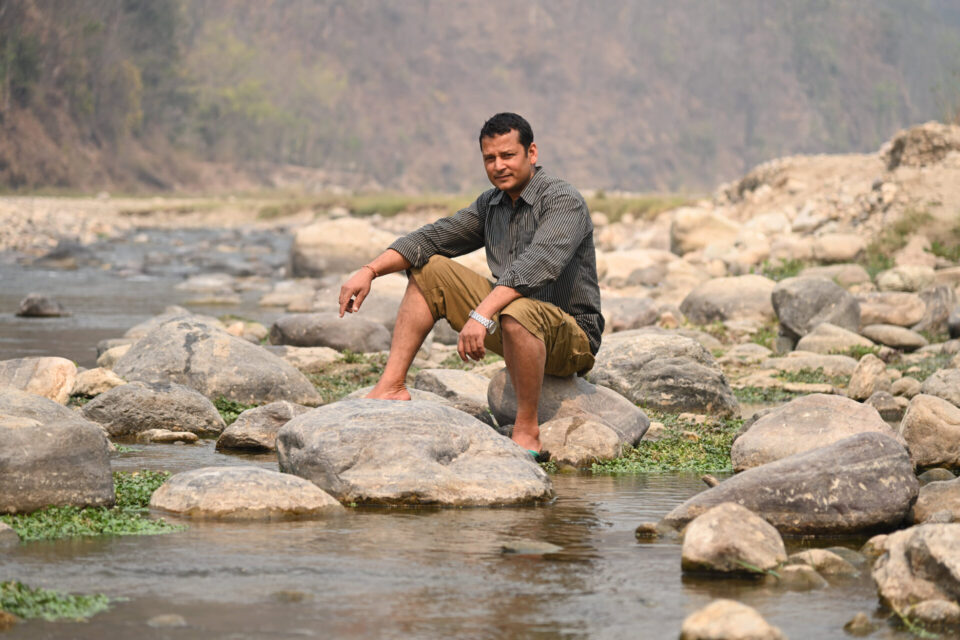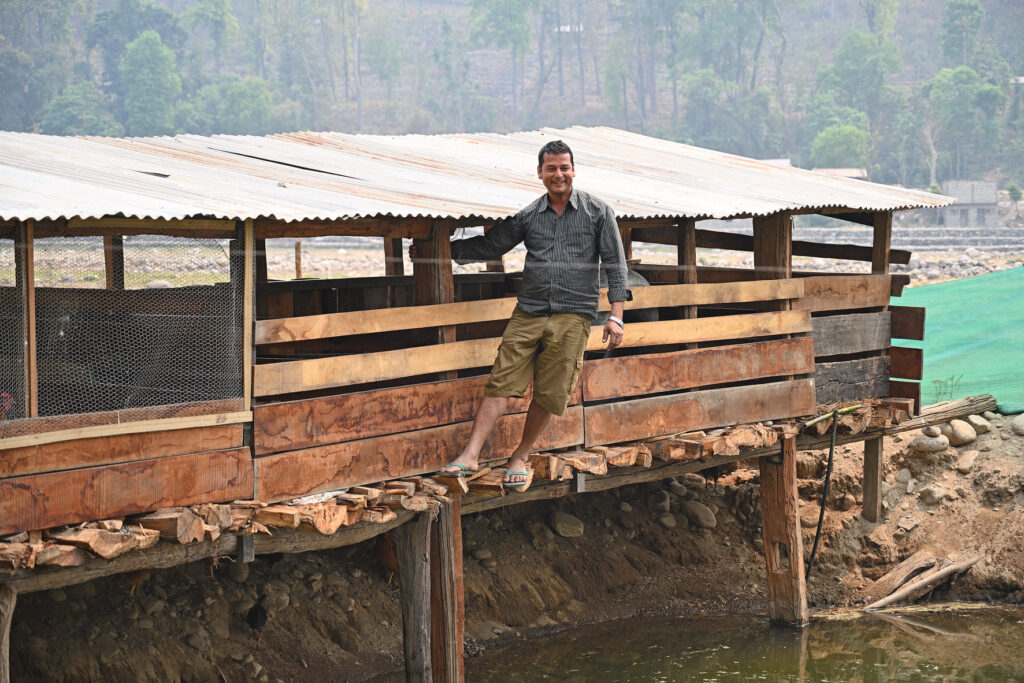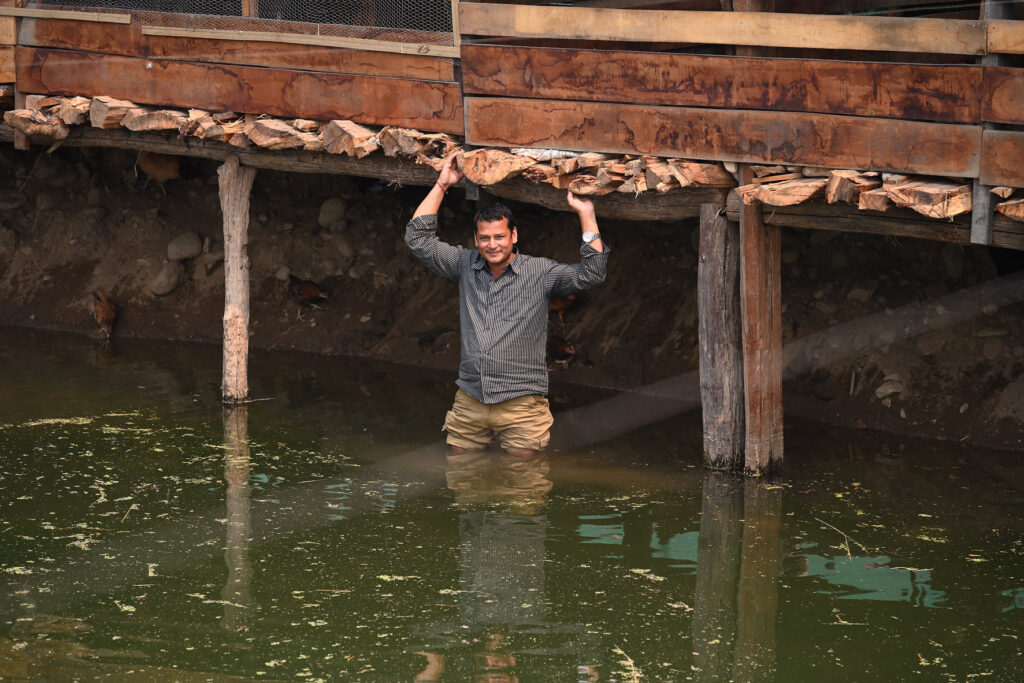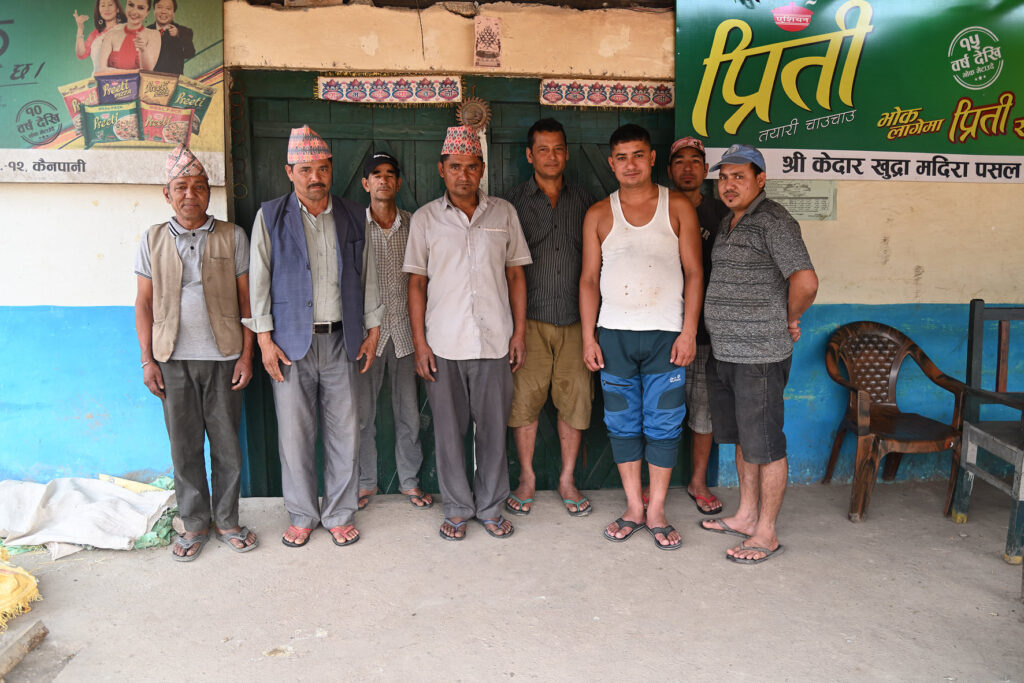
Lal Bahadur Bista Parsuram 1, Maljhul, Dadeldhura
“35 years ago the landscape here changed. People came in from the cities to survey our Khayar trees (acacia catechu). They brought with them some foreigners. In a year or two, there was massive cutting down of these trees. They took it all. That was just the beginning. There was extensive deforestation in the area. Hunters would roam the jungle shooting wild boars and deers. The forest would catch fire and in a day everything would be gone. The soil would burn and when it rained, it would wash down to the river. The sediment would increase the level of the river, which would then flood our crop fields. We struggled for a long time. Our fields were on the banks of the Rangoon River. The rapid deforestation and forest fires would cause the river to change course and flood our fields. The entire forests surrounding the inner Madhesh area of Jogbuda was destroyed. Almost all the Sisam trees were cut or burnt. Almost all the Saal trees were killed.
Even before all of this happened, many trees from here to Chiraan, Alitaal were cut and exported to India. We can still see the stumps of the cut trees.It was only when the community forest model was implemented and various user committees were formed that the forest’s destruction stopped. This brought with it the concept and awareness of preservation and conservation. As training programs from the government and the different organizations started, people slowly understood the relationship between nature and their lives. They learned to correlate cause and effect. When the forest came under the direct jurisdiction of the community, people realized the responsibility to preserve it.
With that knowledge, everyone came together. Today, we are happy to share that we have been able to prevent forest fires in our area for the last 10 years. Although some irreversible damage has already been done to the Rangoon River due to the forest fire which damaged vegetation and made the land fragile to erosion and increased turbidity in the river, she has been kind to us
.This is the river; we rely on for our livelihood. This is our source of water for drinking, irrigation for us and a natural habitat for aquatic animals. This is a lifeline for biodiversity and we must protect it. Nevertheless, as I expressed earlier, damages have been done. Some people are ignorant and sometimes selfish. Some take from the river out of need and do not know how to give back to it. I remember 6 years ago in one night I caught 50 kilos of the famous Mahakali Asala fish. Now it is impossible. If I stay all night, I will only get 2 kilos.
I had started bringing in fish from Dhangadi but I am not so happy about what I serve to customers in my hotel. It was not fresh and I would lose sleep at night. Many of my other friends were bringing in fish from Dhangadi and selling it because we could not find fish in the Rangoon River anymore. And we did not want to exploit the river. Some would poison the fishes and catch them, some would use batteries and electrocute them killing hundreds of fishes at once. I could not do that. My heart would not let me.
When I expressed my wish to construct my own fishpond, I received help from the local ward and from the Paani Project. They helped me set up a fish pond and a pig shed on the dyke of the pond so that the pigs waste which could serve as food for the fish and also grow vegetable using the water from the pond. Today I am happy that I have a source of income and something that keeps me busy. Most importantly, I do not have to exploit the Rangoon River. Today, many people visit my pond and ask me questions. They show interest in duplicating the model and setting it up in their own community. It makes me happy. This would tremendously help conserve the river, the aquatic beings that live in water, the plants and also provide a livelihood for families.”

(Lal Bahadur Bista, Parsuram 1, Maljhul, Dadeldhura)
(Lal Bahadur Bista is a local entrepreneur leading a community group of farmers operating multiple schemes including aqua-culture farms, community mill, and now Integrated Fish Farming activities with USAID’s Paani Program support. Mr Bista as a community role model convinces others about how to balance conservation and consumption.)
“३५ वर्ष अघि यहाँको परिदृश्य नै बलदियो । हाम्रो खयरको रूखहरूको सर्भे गर्न शहरबाट मान्छेहरू आएका थिए । तिनीहरूसँग केहि विदेशीहरू पनि आएका थिए । एकदुई वर्षमा नै ब्यापक रूखहरू काटेर सबै उनीहरूले लगे । त्यो त सुरूवात मात्रै रहेछ । यस ठाउँमा ब्यापक वन फडानी भयो । सिकारीहरूले जंगलमा खुलेआम बँदेल र मृग मार्न थाले । जंगलमा डढेलो लगाएपछि झन् सबै कुरो एकैदिनमा खरानी हुनथाल्यो । पानी परेपछि खरानी र माटो बगाएर खोलामा मिसिन थाल्यो । जसले गर्दा खोलाको सतह बढेर हाम्रो बालीनालीमा बाढी पस्न थाल्यो । लामो समयसम्म हामीले संघर्ष गर्नुपर्र्यो । हाम्रो खेत रन्गुन खोलाको किनारमा थियो । द्रुत वन फडानी र डँढेलोले गर्दा खोलाले आफ्नो बाटो बदलेर हाम्रो खेतसम्म आयो । भित्रीमदेश क्षेत्रको जोगबुडा वरिपरीको सबै जंगल सखाप पारिएको थियो । प्राय सबै सिसौका रुखहरू काटिए वा जलाइए । प्राय सबै सालका रुखहरू पनि ढालिए ।यो सबै हुनुभन्दा अघि पनि यहाँबाट चिरान, आलितालसम्मका सबै रूखहरू काटेर भारत निकासी गरिएको थियो । काटिएका रूखका ठुटाहरू अहिले पनि देख्न सकिन्छ ।विभिन्न वन उपभोक्ता समितीहरू गठन भएर समुदायमा आधारित वन उपयोग प्रणाली कार्यान्वयनमा आएपछि मात्रै हो वन विनाश रोकिएको । वन जोगाउने र संरक्षण गर्ने सोच र जनचेतना यसैले ल्याएको हो । सरकार र अन्य निकायहरूले दिएको तालिम कार्यक्रमबाट प्रकृती र जीवन बीचको सम्बन्ध बारे मानिसहरूले विस्तारै बुझ्दै गए । तिनीहरूले कारक र असरको सहसम्बन्ध पनि बुझे । जब वनको सम्पुर्ण क्षेत्राधिकार समुदायमा आयो, तब मानिसहरूले यसको संरक्षणका लागि दायित्वबोध गर्न थाले ।त्यहि ज्ञानले मानिसहरू एकजुट हुन थाले । विगत १० वर्ष देखि हाम्रो क्षेत्रलाई हामीले डँढेलोबाट जोगाइरहेकाछौँ भन्ने कुरा आज तपाइँलाई सुनाउन पाउँदा मलाई खुसी लागिरहेको छ । बिगतमा डँढेलोले वनस्पतीहरूमा हानी पुर्र्याएका कारण माटो कमजोर भएको हुँदा रन्गुन खोलामा अपुरणिय क्षति भएको छ । खोलाको पानी धमिलो भएपनि हामीलाई यिनले दया नै गरिरहेकिछिन् । जीवकोपार्जनका लागि हामी यहि खोलामा निर्भर छौँ । यसबाट हामीले पिउन र सिँचाइको लागि पानी पाउँछौँ भने जलचर जीवहरूले प्राकृतिक बास पाउँछन् । यो नै जैविक विविधताको रक्षक भएकाले हामीले यसको संरक्षण गर्नुपर्छ । जे होस्, मैले अघि नै भनिसकेँ क्षति त भई नै सक्यो । केहि मानिसहरू अशिक्षित छन् त केहि स्वार्थी । कसैले आवश्यकताका कारण नदीबाट केहि लिन्छन् तर नदीलाई फिर्ता कसरी दिने थाह पाउँदैनन् । ६ वर्ष अघि एकै रातमा महाकालीको प्रसिद्ध असला माछा ५० किलो समातेको मलाई याद छ । अहिले त असम्भव नै छ । एक रात बसियो भने पनि २ किलो मुस्किलले समातिएला ।मेरो होटेलमा आउने ग्राहकहरूको लागि चाहिने माछा धनगढीबाट मगाउन थालेको थिएँ । म त्यति खुसि थिइन । ताजा नहुने भएकोले मलाई रातभर निन्द्रा पर्दैन थियो ।रन्गुन खोलामा माछा पाइन छाडेकाले मेरा अरू साथीहरूले पनि धनगढी बाटै माछा मगाउन थाले । अनि हामीलाई खोलाको शोषण गर्न पनि मन थिएन । पानीमा बिष हालेर, ब्याट्रीको प्रयोग गरी करेन्ट लाएर एकैपटक सयौँ माछा मार्नेहरू पनि थिए । मलाई त्यस्तो गर्न मन लाग्दैन थियो । मेरो मनले मलाई त्यस्तो गर्न दिँदैन थियो ।मेरो आफ्नै माछा पोखरी बनाउने इच्छा मैले व्यक्त गरेपछि वडा कार्यालय र पानी परियोजनाबाट मलाई सहयोग मिल्यो । उहाँहरूले मलाई माछा पोखरी र पोखरीको छेउमा सुँगुरको खोर निर्माण गर्न सहयोग गर्नुभयो । पोखरीमा सुँगुरको फोहोर जाँदा माछाको लागि पनि आहारा भयो । अनि पोखरीको पानी चैँ तरकारी खेती गर्न प्रयोग गर्न मिल्यो । मसँग आय आर्जनको स्रोत र व्यस्त भइरहने केहि मेलो भएकाले आज म खुसि छु । सबैभन्दा महत्वपुर्ण कुरो, रन्गुन खोलाको दोहन गर्नुपरेको छैन । आजकाल धेरैजना मेरो पोखरीमा आउँछन् र अनगिन्ती प्रश्नहरू सोध्छन् । मैले गरिरहेकै काम उनीहरूको ठाउँमा पनि गर्न चासो दिन्छन् । यसले मलाई खुसि दिन्छ । यसले एकातिर खोलानाला, पानीमा बस्ने जीव र वनस्पतीहरूलाई जोगाउन अत्यन्तै ठूलो सहयोग गर्छ भने अर्कोतिर मानिसहरूको जीविकोपार्जनका लागि पनि राम्रो स्रोत उपलब्ध गराउँछ ।”(लाल बहादुर बिस्ट, पर्सुराम-१, मालझुल, डढेलधुरा)___________(लाल बहादुर बिस्ट स्थानिय उद्यमी हुन् । युएस्एडको पानी परियोजनाको सहयोगमा किसानहरूद्वारा सञ्चालित सामुदायिक मिल र एकिकृत माछा पालन जस्ता बहुआयामिक कार्यहरूका लागि सामुदायिक समुहको नेतृत्व गर्छन् । समुदायको प्रेरणाको स्रोत बनेकाले उनी अरूलाई समेत संरक्षण र उपभोगलाई सन्तुलनमा राखी व्यवसाय गर्न सम्झाउँछन्







